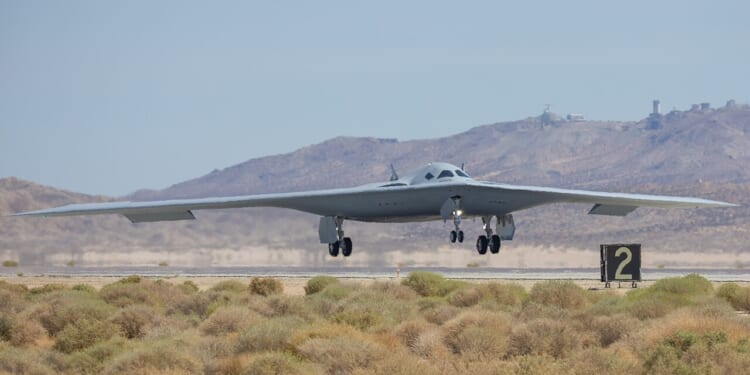Even a handful of B-21s, paired with “loyal wingman” drones and equipped with long-range weapons, are enough to seriously complicate China’s plans for its part of the world.
A second B-21 Raider long-range stealth bomber was recently seen cruising around the airspace at the US Air Force’s Edwards Air Force Base, where the planes are being developed in relative secrecy. These birds are intended to replace America’s aging fleet of 19 B-2 Spirit stealth bombers.
This aircraft, produced by Northrop Grumman, arrived at Edwards the same day as its maiden flight, marking a significant turning point in the development of the B-21. The second B-21 Raider expands testing beyond basic flight performance to include weapons integration, mission systems, and advanced capabilities like sensors and electronic warfare.
What We Know About the B-21 Raider’s Specs (So Far)
- Year Introduced: 2023 (first flight; not yet in operational service as of 2025)
- Number Built: 3 (test and initial production aircraft, as of 2025)
- Length: ~69 ft (21 m)
- Height: ~20 ft (6.1 m)
- Wingspan: ~140 ft (43 m)
- Weight:
- Empty: Classified (estimated ~60,000–70,000 lbs)
- Standard conditions: Classified
- Maximum takeoff weight: Estimated ~140,000 lbs (official figure not released)
- Engines: Two Pratt & Whitney turbofan engines (exact model classified; believed to be derivatives of the F135 or a new variant)
- Top Speed: High subsonic (exact figure classified)
- Range: ~6,000 mi (9,600 km) unrefueled (officially “intercontinental”)
- Service Ceiling: Classified (estimated ~50,000 ft)
- Loadout:
- Internal bays only (stealth optimized)
- Conventional or nuclear ordnance
- Precision-guided munitions (JDAM, JASSM, etc.)
- Nuclear gravity bombs (B61-12, B83, etc.)
- Potential future hypersonic/stand-off weapons
- Aircrew: 2 (pilot + mission commander; capable of uncrewed/remote operations in the future)
The Second B-21 Just Hit the Skies
Sightings of the B-21 flying near the base are part of an accelerating test regimen, with up to six test aircraft eventually planned. A third B-21 was also in ground testing as of September 2024. The program remains highly classified, but public announcements confirm it is on track for low-rate initial production, with operational deployment as early as 2027.
The question remains—both on the minds of American leaders and those of adversary nations—as to whether the United States can build enough of these systems in a timely manner to make them worth the investment, and a true threat to America’s enemies.
As the Air Force’s first sixth-generation aircraft, the B-21 Raider is a strategic bomber capable of delivering both nuclear and conventional payloads in a high-threat environment. The original concept of the B-21 was intended to eventually replace not only the B-2s but also the B-1 Lancer and the B-52 Stratofortress. However, that initial plan is very much in doubt today, given the expense involved in building individual B-21 airframes.
The Pentagon appears to believe that even a handful of these advaned planes could tip the scales in America’s favor in any engagement with America’s rivals, such as China or Russia. The B-21 is thought to include a radar cross-section (RCS) that is even smaller than that of the B-2, already practically invisible to all but the most advanced radars.
The B-21 Raider Could Lead a “Family” of Systems
The Raider is developed with an open systems architecture in mind. Therefore, the plane will be constantly upgraded and integrated with unmanned systems over time. Its proponents claim that the production and maintenance costs will therefore be lower than purpose-built aircraft like the B-2 Spirit in the long run.
More importantly, the B-21 is part of the US military’s “family of systems.” Raiders conducting strike missions could coordinate electronically with F-35 Lightning II warplanes, drones, and satellites for multi-domain operations. This shifts from standalone platforms, essentially creating a tapestry of advanced platforms—both manned and unmanned—that will work in tandem to destroy America’s enemies.
How Will China Respond to the B-21?
China, the top rival of the United States, is not sitting still, even as the second B-21 does more intensive tests of its airpower. Beijing claims it can shoot the B-21 down with hypersonic missiles and systems driven by artificial intelligence.
China has created very dense anti-access/area-denial (A2/AD) “bubbles” that even stealthy B-21s would have difficulty penetrating those systems. At the same time that it flies the B-21, the Air Force is testing long-range weapons that would keep the stealth bomber out of the range of China’s most advanced A2/AD systems, all while still causing massive damage to the enemy.
The real issue is that the Americans likely cannot afford to produce enough of these B-21 Raiders. That gives China significant advantages right off the bat. While some B-21s are likely better for the US military than none, having an insufficient number of these systems means that they will be too expensive to lose, and too few in number to realistically flip the balance of military power back in America’s favor in any large-scale conflict. This, at least, is China’s estimate of events.
Make no mistake, though: even a handful of B-21s, paired with “loyal wingman” drones and equipped with long-range weapons, are enough to seriously complicate whatever plans for their part of the world the Chinese have. The Air Force must press ahead with the B-21. Time is not on America’s side.
About the Author: Brandon J. Weichert
Brandon J. Weichert is a senior national security editor at The National Interest. Recently, Weichert became the host of The National Security Hour on America Outloud News and iHeartRadio, where he discusses national security policy every Wednesday at 8pm Eastern. He is also a contributor at Popular Mechanics and has consulted regularly with various government institutions and private organizations on geopolitical issues. Weichert’s writings have appeared in multiple publications, including The Washington Times, National Review, The American Spectator, MSN, The Asia Times, and others. His books include Winning Space: How America Remains a Superpower, Biohacked: China’s Race to Control Life, and The Shadow War: Iran’s Quest for Supremacy. His newest book, A Disaster of Our Own Making: How the West Lost Ukraine is available for purchase wherever books are sold. He can be followed via Twitter @WeTheBrandon.
Image: Wikimedia Commons.

















